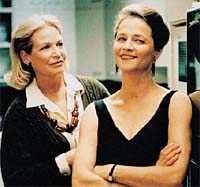 |


|
|
|
|
Film Review by John Demetry
 Queer filmmaker Francois Ozon is still a tantalizing question mark. However,
there is no question about his latest film, Under the Sand. Ozon finally
sustains his enigmatic and teasing style in feature-length form.
Queer filmmaker Francois Ozon is still a tantalizing question mark. However,
there is no question about his latest film, Under the Sand. Ozon finally
sustains his enigmatic and teasing style in feature-length form.
He accomplishes this by concentrating on Charlotte Rampling's character and performance. Ozon scrutinizes both the character's actions and Rampling's portraiture. Even Rampling's application and removal of makeup define shifts in the character's psyche. Ozon also explores the facets of Rampling as a cinematic subject: an exquisite, weathered face used for expressive purposes. Playing a literature professor, Rampling reads to her students from Virginia Woolf's The Waves: "I have lost my youth." Ozon highlights photographs of a younger Rampling that remind of her famous beauty of the 1970s, including one of her posed wearing a swimsuit by a beach. In the film's beginning, she and her husband (played by Bruno Cremer) vacation near a beach. Signs of marital tedium are acted out. Rampling conceals the bags under her eyes before joining her husband in bed. She hopes to make love on the first night of their vacation. "Are you tired?" she asks him. "Oui," he answers, keeping his back to her. She smiles, finding his seriousness endearing. Ozon's framing of Cremer's large mass in the foreground impresses a disturbance in their relationship that Rampling ignores -- just as she will later ignore that he has left her. Overweight with a large mole on his cheek, Cremer's mouth crawls discontentedly across his face. Yet from the eyes up, he's quite handsome. Those perceiving pools possess the tumultuous cold blue waters of depression. Such a subtle performance, Cremer essays his despair with the creases in his forehead. One sequence significantly features her husband alone gathering wood for a fire. The sequence offers a clue to the film's mysteries. Cremer strokes the bark of tree. Then, Ozon's panning camera brings a close-up of sinuous, moss-covered bark into focus. Cremer lifts a log and stares intently at the unveiled terra incognita that Ozon raises to a roaring volume. In this brief sequence, Ozon invites the audience into Cremer's perspective of the world. Rampling dominates the rest of the film. While Rampling tans and naps on the beach, Cremer goes for a swim. When she awakens, he has disappeared.
Ozon's perverse manipulations complicate that realism. Every scene transition makes use of unnerving suspense techniques: sudden changes from dark to light; sound busses. The technique underscores Rampling's inability to grieve her husband. It also involves the audience sensuously -- like an orgasm delayed. Ozon wrinkles the texture of Rampling's ruptured psyche during two scenes that epitomize his sexual playfulness and skeptical pop romanticism. The first begins with an oblique overhead angle of a bed -- both times I saw the film, I thought the projector had slipped! Rampling lies back on the bed and imagines the hands of her husband and her future lover fondling her body while she masturbates. Then, after her first sexual experience with her new lover, Rampling gets moony while she grocery shops. Ozon uses a French pop ditty, "You're the Sun," as the soundtrack. Both scenes swoon -- threatening a collapse. Most disturbingly, Rampling imagines that her domestic relationship with her husband continues. Ozon integrates these scenes into the style of the rest of the film, confusing all notions of "reality" and "fantasy." Every moment must be understood as a psychosexual reality. Giddy after the answering machine message from her suitor, Rampling summons guilt in the form of her husband. Reading from The Waves, she conjures into her classroom the most beautiful and youthful of the lifeguards who helped search for her husband at the beach. His cluster of dark curls makes him an ideal Ozon dream boi.

Even the husband's death/disappearance might be construed simply as wish fulfillment. After all, Rampling fantasizes a happier and more attentive husband while making herself available for an affair. The resulting journey, however, is more complex. A study in narrative theory -- Ozon doesn't quote Woolf's The Waves for nothing -- Under the Sand extends this inquiry into the mystery of sex. Ozon uncovers a fundamental emotional quandary. Though populated by hetero characters, this is true Queer cinema. In the final scene, Rampling returns to the scene of the crime. There, the spectacle of an actress' understanding and a character's emotional revelation coalesce through Ozon's grace. The final haunting image: footprints trace the shape of a question mark in the sand. |

© 1997-2002 BEI